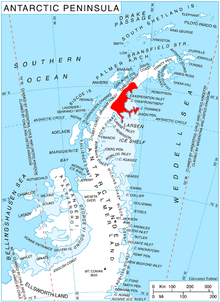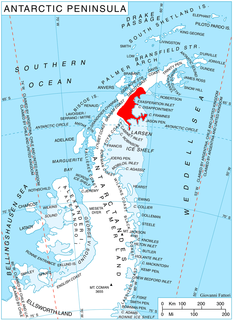
The Queen Elizabeth Range is a rugged mountain range of the Transantarctic Mountains System, located in the Ross Dependency region of Antarctica.

The Ohio Range is a mountain range in the Transantarctic Mountains of Antarctica. It is about 48 km (30 mi) long and 16 km (10 mi) wide, extending WSW-ENE from Eldridge Peak to Mirsky Ledge. The range forms the northeast end of the Horlick Mountains and consists primarily of a large snow-topped plateau with steep northern cliffs and several flat-topped ridges and mountains. The highest point is the summit of Mount Schopf.

The Usarp Mountains is a major Antarctic mountain range, lying westward of the Rennick Glacier and trending N-S for about 190 kilometres (118 mi). The feature is bounded to the north by Pryor Glacier and the Wilson Hills. Its important constituent parts include Welcome Mountain, Mount Van der Hoeven, Mount Weihaupt, Mount Stuart, Mount Lorius, Smith Bench, Mount Roberts, Pomerantz Tableland, Daniels Range, Emlen Peaks, Helliwell Hills and Morozumi Range.

Jaburg Glacier is a broad glacier draining westward between the Dufek Massif and the Cordiner Peaks in the Pensacola Mountains of Antarctica. It was mapped by the United States Geological Survey from surveys and U.S. Navy air photos, 1956–66. The glacier was named by the Advisory Committee on Antarctic Names after Lieutenant Conrad J. Jaburg, U.S. Navy, a helicopter pilot with the Ellsworth Station winter party, 1957.
Le Couteur Glacier is a glacier, 15 nautical miles (28 km) long, which drains the northwest slopes of Mount Hall and Mount Daniel and flows north along the west side of the Lillie Range to the Ross Ice Shelf, Antarctica. It was named by the Southern Party of the New Zealand Geological Survey Antarctic Expedition (1963–64) for P. C. Le Couteur, a geologist with the New Zealand Federated Mountain Clubs Antarctic Expedition, 1962–63.

The Danco Coast is that portion of the west coast of the Antarctic Peninsula between Cape Sterneck and Cape Renard. This coast was explored in January and February 1898 by the Belgian Antarctic Expedition under Adrien de Gerlache, who named it for Lieutenant Emile Danco who died on the expedition.
Mount Antell is a mountain rising above 610 metres (2,000 ft), overlooking the north coast of South Georgia midway between Bjelland Point and Hercules Point. It was surveyed by the South Georgia Survey in the period 1951–57, and named by the UK Antarctic Place-Names Committee for Georg Antell, foreman of the South Georgia Whaling Company station at nearby Leith Harbour, 1913–39.

Barcus Glacier is a glacier in the Hutton Mountains that drains east-southeast, to the north of Mount Nash and Mount Light, into Keller Inlet in Palmer Land. It was mapped by the United States Geological Survey from ground surveys and from U.S. Navy air photos, 1961–67, and named by the Advisory Committee on Antarctic Names for James R. Barcus, ionospheric physics researcher at Byrd Station in the summers of 1966–67 and 1967–68.
The Brusilov Nunataks are a group of nunataks lying 6 nautical miles (11 km) north of Mount Morrison in the Tula Mountains, Enderby Land. The geology of the nunataks was investigated by the Soviet Antarctic Expedition, 1961–62, which named them after the Russian polar explorer G.L. Brusilov.
Koerwitz Glacier is a low gradient glacier flowing northeast from Mount Griffith in the Hays Mountains of Antarctica to the Karo Hills. It was first seen and roughly mapped by the Byrd Antarctic Expedition, 1928–30. The glacier was named by the Advisory Committee on Antarctic Names for Peter H. Koerwitz, a biolab manager at McMurdo Station in 1965.
Mount Frödin is a mountain, about 600 metres (2,000 ft) high, rising 0.5 nautical miles (1 km) east-southeast of Waterboat Point, Paradise Harbor, on Danco Coast, Antarctica. The feature was originally called "Mount Lunch-Ho!" by T.W. Bagshawe and M.C. Lester, because on the first ascent in 1921 lunch was eaten on the summit. It was renamed by the Chilean Antarctic Expedition (1950–51) after Swedish engineer Bertil Frödin, who conducted geological and glaciological studies on the expedition.
Mount Dowie is a ridgelike mountain which rises to a central crest, about 4 nautical miles (7 km) west of Mount Hollingshead in the Aramis Range, Prince Charles Mountains. It was sighted by the Australian National Antarctic Research Expeditions southern party led by W.G. Bewsher in January 1957, and named for Dr. Donald A. Dowie, medical officer at Mawson Station in 1956.

Driscoll Glacier is a glacier 13 nautical miles (24 km) long in the Heritage Range, draining southeast between the Collier Hills and the Buchanan Hills to enter Union Glacier. It was mapped by the United States Geological Survey from surveys and U.S. Navy air photos, 1961–66, and was named by the Advisory Committee on Antarctic Names for Commander Jerome M. Driscoll, an administration officer with U.S. Navy Squadron VX-6 during Operation Deep Freeze 1965.
Mount Manke is a mountain, 900 metres (3,000 ft) high, marking the eastern limit of the Harold Byrd Mountains in Antarctica. It was mapped by the United States Geological Survey from ground surveys and U.S. Navy air photos, 1960–63, and was named by the Advisory Committee on Antarctic Names for Robert M. Manke, a utilitiesman with the Byrd Station winter party in 1960.
Target Hill is a prominent hill which rises 1,010 m above the level of Larsen Ice Shelf. It stands 6 nautical miles (11 km) west of Mount Fritsche on the south flank of Leppard Glacier in eastern Graham Land. The hill was the most westerly point reached by the Falkland Islands Dependencies Survey (FIDS) survey party in 1955; it was visible to the party as a target upon which to steer from the summit of Richthofen Pass.
Mount Ratliff is a mountain, 2,520 m, located north of Watson Escarpment and 8 nautical miles (15 km) north-northeast of Mount Doumani. Mapped by United States Geological Survey (USGS) from ground surveys and U.S. Navy air photos, 1960-63. Named by Advisory Committee on Antarctic Names (US-ACAN) for Charles E. Ratliff, aviation machinist mate with U.S. Navy Squadron VX-6 in several Operation Deep Freeze deployments, 1963-67.
Mount Lugering is a mountain nearly 2,000 metres (6,600 ft) high on the west side of the Lanterman Range, in the Bowers Mountains of Antarctica. It marks the north side of the terminus of Hunter Glacier where it joins Rennick Glacier. The mountain was mapped by the United States Geological Survey from ground surveys and U.S. Navy air photos, 1960–62, and was named by the Advisory Committee on Antarctic Names for utilitiesman Donald R. Lugering, U.S. Navy, of the South Pole Station winter party, 1965.
Mount Rodger is a sharp peak, 1,410 m, at the northwest end of Collier Hills in the Heritage Range in Antarctica. It was mapped by United States Geological Survey (USGS) from surveys and U.S. Navy air photos, 1961–66 and named by the Advisory Committee on Antarctic Names (US-ACAN) for Rodger A. Brown, meteorologist at Little America V Station in 1958.









